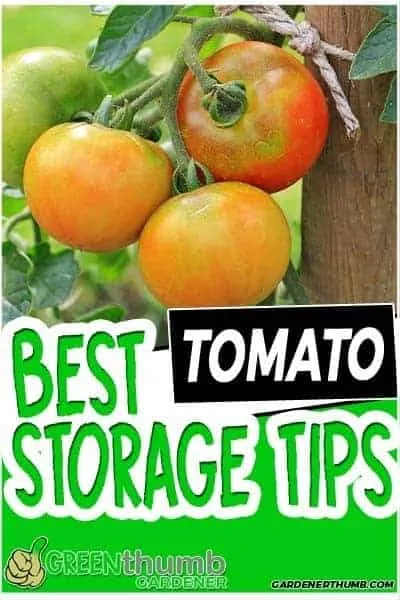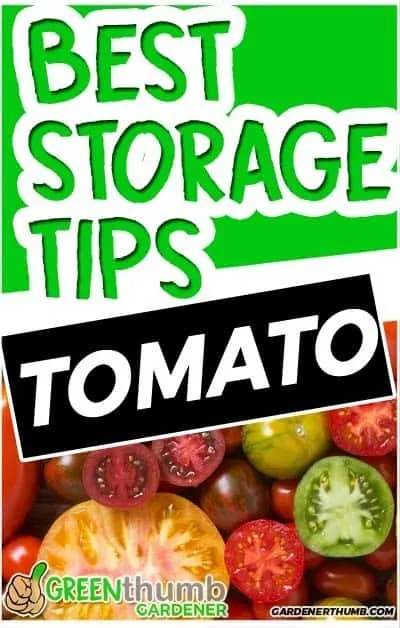How Long Do Tomatoes Last | Best Storage Tips
Last updated: 01/30/20
Tomatoes are technically a fruit, one that does not have an indefinite shelf life. You might be wondering just how long do tomatoes last.
We answer all those questions, plus give you some of the best tips to store & prepare them to last longer. Proper techniques will really help when you are trying to preserve tomatoes.
Tomato’s shelf life is really dependant on your careful preparation and shelf storage practices.
Oxygen, moisture, temperature and light are typically the 4 common spoilers with any food. Keep all of these limited and you will make them last longer.
Here are some common storage times
- Ripe tomatoes will last 7-10 days at room temperature, unripe tomatoes will last an additional 2-5 days depending on how ripe it is
- Ripe tomatoes will last for 5-10 days in the fridge
- Cut tomatoes last about 3-4 days in the fridge
- Canned tomatoes last for 12-18 months
- Frozen tomatoes will last for 3-6 months in the freezer
- Cooked tomatoes will last for approximately 4-6 days in the fridge
- Pickled tomatoes lasts for about 4-6 months if pickled, canned, and stored in a refrigerator properly
Right-from-the-garden tomatoes don’t exist year round, so many of us have to depend on stores for our vegetables and fruits.
Green thumb Gardener occasionally links to product and/or services offered by vendors to assist you with all your gardening needs. Some of these may be affiliate links, meaning we earn a small commission if items are purchased.
Want to Download a Garden Hack Guide for FREE

Enter your email below and we will send you a guide to help you SAVE money in your garden.
Although there are various tomato species out there, every one of them has an almost similar shelf life.
Keep them packed in the refrigerator to allow them to last about two weeks if you intend to enjoy the full benefits of your tomatoes.
Besides that, a tomato over two weeks of age probably shouldn’t be consumed except if you want to endanger your health.
Tomatoes provide a significant source of phytonutrients that support in keeping the skin young and shields the skin from harmful enzymes.
The rationale behind our advice is that you implement food preservation methods appropriately. Additionally, you should use your professional instincts to determine whether something is spoiled.
You will learn about the shelf life of tomatoes, plus some tips on how to make tomatoes last longer.
1 – Shelf Life of Tomatoes at Room Temperature
Tomatoes can either be fresh or canned.
The majority of ripe tomatoes maintain their eating quality at room temperature for about 7 to 10 days.
Canned tomatoes last for about 18 months if unopened.
You should also be conscious that there are different types of tomatoes, like cherry tomatoes, plum tomatoes, and grape tomatoes.
It is recognized that the shelf life of plum tomatoes is longer than any other form of tomato, because of its hardened flesh.

Keep them away from sunlight with the stem scar facing upward to minimize darkening and softening of the fruit.
Unripe tomatoes from a grocery store can be kept for an additional 3-5 days.
For brief storage, the tomatoes should be kept at the coolest possible room temperature inside a paper bag or in a respired ripening dome.
Ensure that the tomatoes are kept away from direct sunlight because sunlight warms up the fruit and it softens faster.
Canned Tomatoes
Things are somewhat different for canned tomatoes. Unopened, canned tomatoes can only last on the shelf or in a fridge from 12 to 18 months.
They don’t usually last that long in our house because we go through a good amount of sauce.
It’s great if you realize you want tomatoes for cooking, but you don’t know how many of your cooking will require or how many you will use at a time.
Although, you should ensure that you use every bit of the canned tomato as quickly as possible after you open it since you have approximately seven days to use them after it has been opened.
2- How Long Do Tomatoes Last in the Fridge | Shelf Life of Tomatoes in the Fridge
You should put them in the refrigerator if you want your tomatoes to last for about 10 days and if you wish to gain much from them.
Other than this, a tomato, which is older than two weeks, is probably not meant for eating except you want to chance getting sick.
Ripe tomatoes that you cannot use instantly should be placed inside the fridge. Doing so will delay or even stop the ripening substantially, preventing them from rotting quickly.
According to some experts, you should ensure your refrigerated tomatoes are out of the fridge for 24 hours before using them, as it will help restore any missing taste during the cooling process.
Unripe tomatoes should be placed in a cabinet or on the counter until usage (which should be sooner after purchase for fresh tomatoes).
This is because refrigerating them delays the ripening considerably. For certain cases the ripening will be all-together halted, meaning that the tomatoes will remain unripe.
3- Shelf Life of Tomatoes in the Freezer
Tomatoes are very easy to freeze and they can last for up to 6 months in the freezer.
When appropriately stored, tomatoes will retain the best quality for 3 months, but after that they slowly deteriorate in flavor over several months.
Tomatoes which have been continually frozen at 0°F are healthy forever. The freezer period displayed is of the highest quality only.
If you have loads of ripe tomatoes you will not be used for quite a while, you should freeze them. One technique is to just freeze them without much preparation.

Before doing this, wash them and rub them dry. Next, arrange them on a tray and ensure they don’t contact each other before placing them in the freezer. After it is frozen, offload to a container or freezer bag.
When thawed, the tomatoes are soft as a result of cell damage from freezing. This ensures they’ll only be nice to cook with.
They aren’t going to be good for fresh eating. The freezing phase loosens the skin though, making it much simpler to remove them.
4- How Long Do Cooked Tomatoes Last | Cooked Tomatoes Shelf Life
Cooked tomatoes in the refrigerator can last for about 4-6 days.
Refrigerate the tomatoes in small sealed containers or zip-lock paper bags to improve the shelf-life for quality and safety of cooked tomatoes.
Bacteria develop quickly at temperatures between 40 and 140 degrees Fahrenheit; cooked tomatoes must be thrown away if abandoned at room temperature after 2 hours.
Freeze them in covered sealed containers or freezer bags to extend their shelf life.
5- How to Properly Store Tomatoes | Best Ways to Store Tomatoes
Hold the stem of unripe tomatoes side down, in a cardboard box or paper bag, in a single layer, then store in a cold place, until the color turns red.
Fully ripe tomato must be placed on the shelf protected from sunlight at room temperature.
Ensure they are in a single sheet and don’t contact each other, and the stem should be facing up. Use them within a few days.
The fridge is the best place to store overripe tomatoes which are soft and has pure red flesh.
The moist air prevents the tomatoes from ripening, so they will last for an extra three days.
6- How to Know if Tomatoes are Bad or Spoiled
As with most vegetables, when tomatoes surpass their shelf life it quickly becomes apparent.
Look for these signs to tell if it has gone bad.
Skin Softening
The first symptom will be skin softening.
This may be impossible to notice at first because tomatoes are somewhat soft vegetables.
You can check this when you first purchase them at the market or farmer stand.
Give it a gentle squeeze with indicate if there are some soft spots.
Leaking Liquid
A further sure sign that your tomatoes are rotting is when they start leaking liquid. It is an indication you should definitely think about cooking the tomato because they are ready to turn.
Mold
The tomato starts growing mold once it is past the soft and liquid signs. You can throw the tomatoes in your compost pile at this point because it is spoiled.
Fruit Flies
A further effective way of telling if your tomatoes have issues is by noticing fruit flies. Fruit flies get drawn to fruit, as the name suggests, and the tomatoes are also technically classified as fruits.
No one likes to eat tomatoes with flies on it or inside it. Placing the tomatoes in the fridge or freezer is another effective way to avoid this.

Further Reading
7- Methods to Make Tomatoes Last
Tomatoes can be stored for quite some time depending on how you store them. There is nothing like making some sauce in the dead of winter from your previous seasons crops.
Let’s take a look at a few different ways on preserving tomatoes.
Freezing Your Tomatoes
The best way to make tomatoes last is by freezing chopped or cut tomatoes. There are some steps you need to complete before you freeze them:
- Blanch, or boil the tomatoes in boiling water for approximately 2-3 minutes.
- Remove from the boiling water after 3 minutes and submerge in a cold ice bath. This stops the cooking process.
- At this point you may remove the outer skin of the tomatoes. (optional)
- Drain the tomatoes and pat dry as best as possible.
- Place tomatoes and pieces on a tray lined with parchment paper.
- Place in the freezer for approximately 45 minutes to an hour. This will ensure that the tomatoes freezes but does not clump together.
- Place frozen tomatoes in a tightly sealed bag. Vacuum sealed bags are the most optimal way.
Pickling Tomatoes
This method preserves the tomatoes in a salty, briny pickling liquid. Pickling is almost always a liquid that is composed of vinegar, sugar and/or salt.
It also can include some other spices that lend well to the pickling flavors that you are most familiar with.
Typically, pickled tomatoes will last about a few weeks in the fridge. The combination of vinegar and salt provides a very acidic environment that impedes bacteria.
You definitely still want to keep it covered and stored in the fridge.
Canning Tomatoes
There are 2 methods of canning that we must discuss. There is the water bath canning method and there is pressure cooking canning. Tomatoes require the water bath canning method.
Water bath canning is strictly for high-acid fruit & vegetables. Tomatoes are on the cusp of this, but adding some lemon juice to the batch does make it an acidic environment.
You need to follow any guidelines for canning strictly for this very reason.
Pressure cooking canning methods can still be used with tomatoes, but it is not a requirement.The best guide that we use for canning and pickling is the Ball Complete Book of Home Preserving. You can find this book here.
Other Methods To Make Tomatoes Last
Dehydrating tomatoes is another fantastic ways to preserve tomatoes. You may have used these in any recipe that calls for sun dried tomatoes.
These are in fact dehydrate tomatoes.
Dehydrating basically dries the tomatoes of 90-95% of its water content. This slows down the rate at which tomatoes spoils.
You still need to store it in an airtight container to maximize its shelf life.
Some have even made a powder out of the tomatoes instead of reconstituting them. You will need to dry for just a bit longer.
More info
Keep in mind that the information that we provided is based on recommendations from the FDA, our own observations, and the data from other sources such as the Ball guide we mentioned above.
Please do your own due diligence in determining your own set of guidelines.
This information provided is at your own risk. Use your best judgment. We did our best to present you with the best information we had available at the time of this writing.
The shelf lifetimes are based on the following conditions of your storage area:
- Room temperature of 60°- 70°F
- Refrigerator temperature of 35° – 40° F
- Freezer temperature of 0°F or lower.
Check out our guide on ways of preserving food for more information on some of the techniques.
Related Questions
- How long do tomatoes last after the cut? – Tomatoes will last for less than 1 day if left outside of the fridge and 3-4 days in the fridge.
- How long do tomatoes last after picking? – This depends on how ripe tomatoes were prior to picking them. Generally, between 7 days to as long as 14 days.








